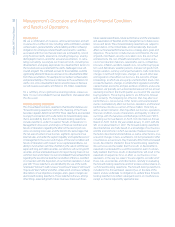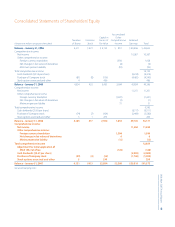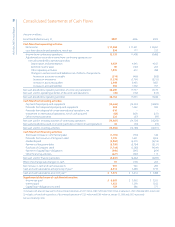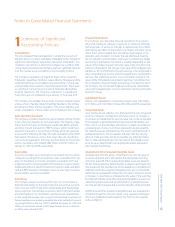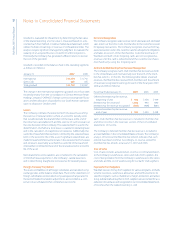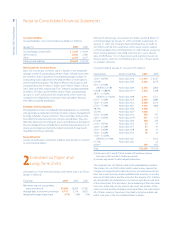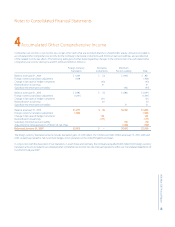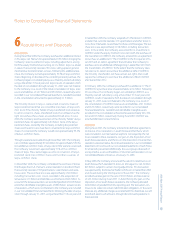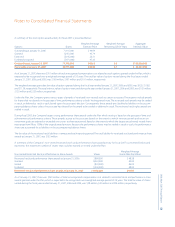Walmart 2007 Annual Report Download - page 49
Download and view the complete annual report
Please find page 49 of the 2007 Walmart annual report below. You can navigate through the pages in the report by either clicking on the pages listed below, or by using the keyword search tool below to find specific information within the annual report.
Wal-Mart 2007 Annual Report 47
In connection with the Company’s borrowing arrangements, the
Company is not required to observe nancial covenants. However,
under certain lines of credit totaling $6.0 billion, which were undrawn
as of January 31, 2007, the Company has agreed to observe certain
covenants, the most restrictive of which relates to minimum amounts
of additional secured debt and long-term leases. In addition, one of
our subsidiaries has restrictive nancial covenants on $2.0 billion of
long-term debt that requires it to maintain certain equity, sales, and
pro t levels. The Company was in compliance with these covenants
at January 31, 2007.
Long-term debt is unsecured except for $333 million, which is
collateralized by property with an aggregate carrying value of
approximately $1.3 billion. Annual maturities of long-term debt
during the next five years and thereafter are (in millions):
Fiscal Year Ended January 31, Annual Maturity
2008 $ 5,428
2009 4,499
2010 4,621
2011 2,875
2012 2,523
Thereafter 12,704
Total $32,650
The Company has entered into sale/leaseback transactions involving
buildings while retaining title to the underlying land. These transactions
were accounted for as nancings and are included in long-term debt
and the annual maturities schedule above. The resulting obligations
mature as follows during the next ve years and thereafter (in millions):
Fiscal Year Ended January 31, Annual Maturities
2008 $ 10
2009 10
2010 10
2011 10
2012 10
Thereafter 300
Total $350
The Company had trade letters of credit outstanding totaling $3.0 billion
and $2.6 billion at January 31, 2007 and 2006, respectively. At January 31,
2007 and 2006, the Company had standby letters of credit outstand-
ing totaling $2.2 billion and $2.3 billion, respectively. These letters of
credit were issued primarily for the purchase of inventory and self-
insurance purposes.
3 Financial Instruments
The Company uses derivative nancial instruments for hedging and
non-trading purposes to manage its exposure to changes in interest
and foreign exchange rates. Use of derivative nancial instruments in
hedging programs subjects the Company to certain risks, such as
market and credit risks. Market risk represents the possibility that the
value of the derivative instrument will change. In a hedging relation-
ship, the change in the value of the derivative is o set to a great extent
by the change in the value of the underlying hedged item. Credit risk
related to derivatives represents the possibility that the counterparty
will not ful ll the terms of the contract. The notional, or contractual,
amount of the Company’s derivative nancial instruments is used to
measure interest to be paid or received and does not represent the
Company’s exposure due to credit risk. Credit risk is monitored through
established approval procedures, including setting concentration limits
by counterparty, reviewing credit ratings and requiring collateral
(generally cash) when appropriate. The majority of the Company’s
transactions are with counterparties rated “AA-” or better by nationally
recognized credit rating agencies.
Fair Value Instruments
The Company enters into interest rate swaps to minimize the risks
and costs associated with its nancing activities. Under the swap
agreements, the Company pays variable-rate interest and receives
xed-rate interest payments periodically over the life of the instruments.
The notional amounts are used to measure interest to be paid or
received and do not represent the exposure due to credit loss. All
of the Company’s interest rate swaps that receive xed interest rate
payments and pay variable interest rate payments are designated
as fair value hedges. As the speci c terms and notional amounts of
the derivative instruments exactly match those of the instruments
being hedged, the derivative instruments were assumed to be per-
fectly e ective hedges and all changes in fair value of the hedges
were recorded on the balance sheet with no net impact on the
income statement.
Notes to Consolidated Financial Statements



